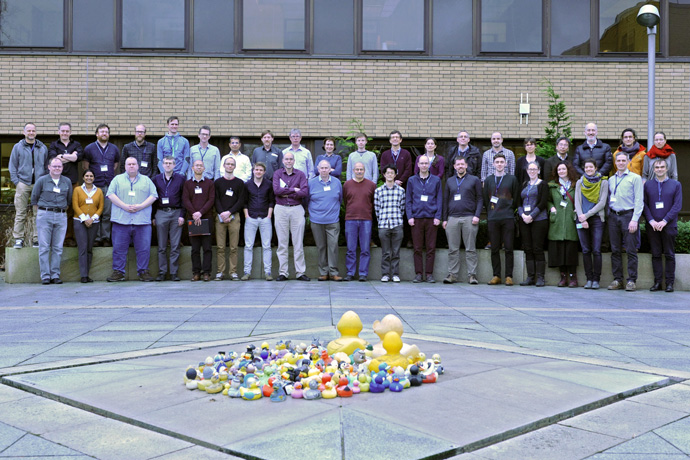ECMWF | Reading | 22-25 January 2018

Workshop Announcement
An accurate characterisation of the ocean in terms of its surface temperature and sea ice coverage is vital for Numerical Weather Prediction (NWP) forecasts a few days in advance out to the seasonal range. This workshop was organised to bring together experts involved in all aspects of this field, including the treatment of ocean surface observations (both satellite and in situ), data assimilation techniques and modelling. Three days of presentations was followed by working group meetings which assessed the current state of the art and identify areas where significant improvements and progress can be made.
Description
A key part of the ECMWF new strategy is to develop an Earth-system analysis and forecast system, and to introduce more coupling in data assimilation and the forecasting model since this could be the best way to extract predictable signals from the initial conditions, and thus improve the quality of our forecasts. This will imply further developing the ECMWF prototype coupled assimilation that has been used to generate the first European coupled reanalysis of the 20th century. ECMWF new ocean reanalysis/analysis ORAS5, at a 1⁄4 degree resolution and with 75 layers, includes also the sea-ice. In Q4-2016, ECMWF introduced an interactive sea-ice in its medium-range/monthly ensemble (ENS). The development of an ECMWF’s own sea-surface temperature (SST) data assimilation capability could be another necessary step to move towards better initial conditions for the coupled model, and to develop a ‘stronger’ coupled data assimilation. This workshop gave us the opportunity to discuss with experts from the international community how best to proceed in this area.
Motivation
The landscape of users and applications of Sea Surface Temperature (SST) and Sea Ice (SI) information has changed considerably in the past few years. Observations, applications and methodologies are undergoing a major shift. In the case of SST and SI, the paradigm of Earth System Forecasting systems has brought together activities and communities traditionally separated, such as the weather and marine communities, and the weather and climate. There is a pressing need to revisit the current practices in view of new potential and current deficiencies, to provide guidelines for future directions and to prepare the ground for institutional collaboration at international level.
Schedule
The workshop took place at ECMWF on 22 - 25 January 2018. It revolved around four central themes:
Session 1: Observations of the SST and SeaIce: overview of observations of SST and sea ice. Remote sensed and in-situ. Past-Present-Future.
Session 2: Processing chains: retrievals, gap filling and product delivery.
Session 3: Applications: defining the observational requirements.
Session 4: New methods.
Working Groups
|
WG1: Observations and Methods processing chains - Frozen (Sea Ice) |
|
|
WG2: Downstream applications of SST and Sea Ice |
|
|
WP3: Observations and Methods processing chains - Unfrozen (SST) |
|
|
Workshop report |
Some questions were addressed:
- Which level of information should be assimilated in NWP for timeliness?
- Which level of information should be used in reanalyses? How to guarantee consistency between reanalyses and real time?
- Are the required data streams in place? how to avoid duplication?
- How to manage different spatial scales?
- How to manage temporal evolution (stability, bias correction, merging old and new methods, timeliness).
- Which other observations should be used?
- Which developments in data assimilation methods are needed?
- Which developments in forward modelling are needed?
Presentations
Monday 22 January
|
Quantifying the thermodynamic state of the global ocean surface |
|
|
Satellite Sea Surface Temperature – current and future observations at ESA |
|
|
Observations of sea-surface temperature made in situ: evolution, uncertainties and considerations on their use |
|
|
Satellite observations of sea ice concentration and drift |
|
|
In-situ and airborne sea ice observations for better sea ice prediction and climate analysis |
|
|
Future ESA satellite missions to observe the ocean and ice surface |
Tuesday 23 January
| Copernicus Sentinel-3 L1 to L4 SST processing chain and GHRSST perspectives Anne O'Carrol (EUMETSAT) |
|
| From L1 to L2 SST: signal/errors and gaps Hervé Roquet (Météo-France) |
|
| From L1 to L2 for sea ice concentration Rasmus Tonboe (DMI) |
|
| Sea ice charts and SAR for sea ice classification Patrick Eriksson (FMI) |
|
| The Operational Sea Surface Temperature and Ice Analysis (OSTIA) system Simon Good (Met Office) |
|
| Reanalysis needs for observations and analyses of sea surface temperature and sea ice: atmospheric perspective Adrian Simmons (ECMWF) |
|
| Climate reanalysis and reforecast needs: An ocean perspective Hao Zuo (ECMWF) |
|
| NWP needs and gaps Kristian Mogensen (ECMWF) |
|
| Use of Sea Surface Temperature and Sea Ice observations for the Copernicus Marine Service and its applications Antonio Reppucci (Mercator-Ocean) |
|
| Ocean data assimilation systems in JMA and their representation of SST and sea ice fields Yosuke Fujii (JMA) |
|
| The CERA-SAT reanalysis: Proof-of-concept for coupled DA in the satellite era Dinand Schepers (ECMWF) |
Wednesday 24 January
| Assimilation of sea surface temperature data in the FOAM ocean forecasting system Matthew Martin (Met Office) |
|
| Optimized assimilation of sea ice in an Earth system model and impacts for climate prediction Madlen Kimmritz (NERSC) |
|
| Assimilating SST with an atmospheric DA system John Derber (NCEP) |
|
| The Gulf Stream signature in sea surface temperature: observations and impact on the North Atlantic storm-track Arnaud Czaja (Imperial College) |
|
| Observation operators for sea Ice thickness to L-band brightness temperature Matthias Drusch (ESA) |
|
| Merged sea ice thickness product from complementary L-band and altimetry information Stefan Hendricks (AWI) |
|
| Sea ice data assimilation for NWP and operational ice services Mark Buehner (Environment Canada) |
Organising committee
Magdalena A. Balmaseda, Patricia de Rosnay, Hans Hersbach, Sarah Keeley, Tony McNally, Steffen Tietsche
